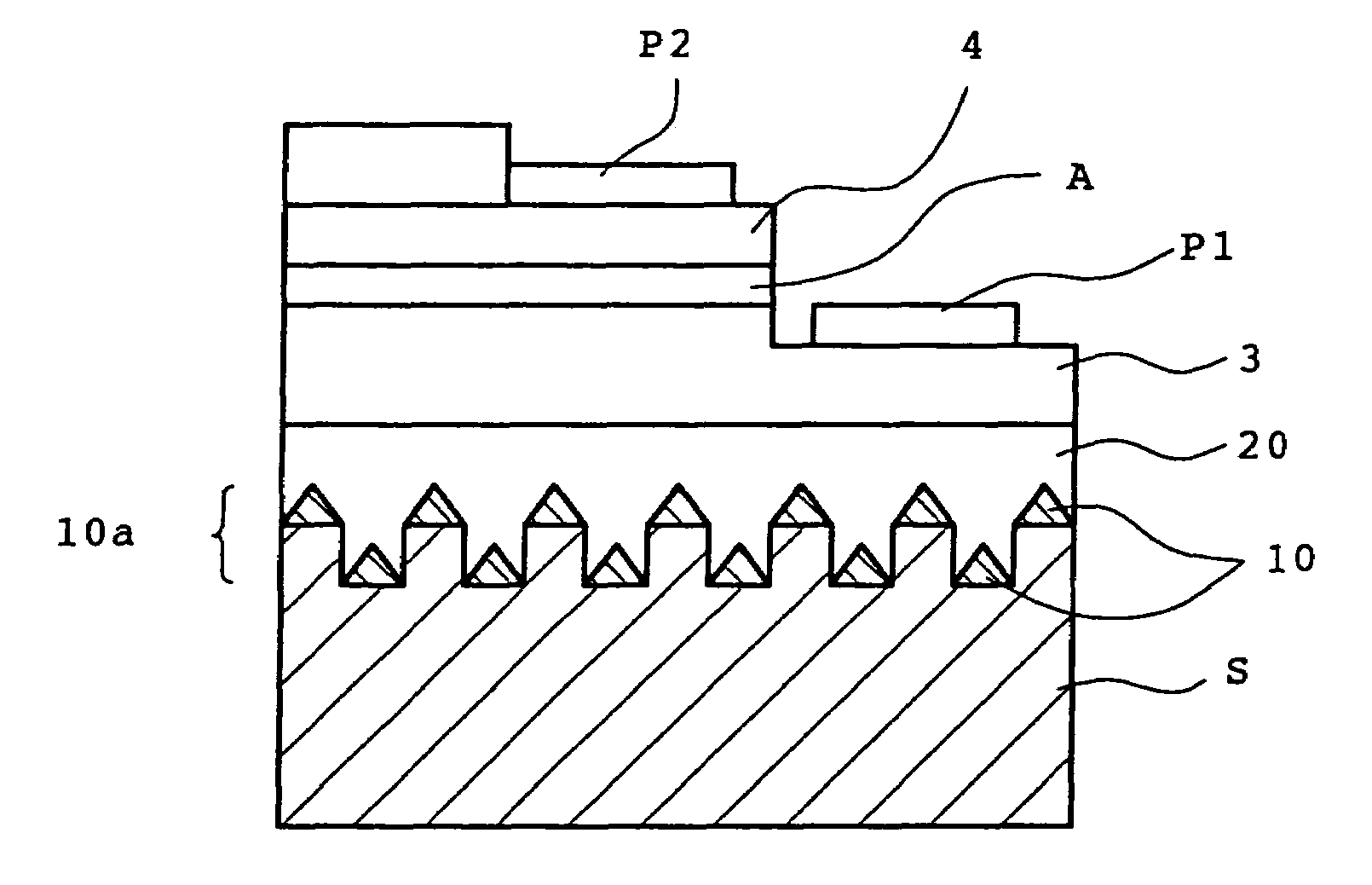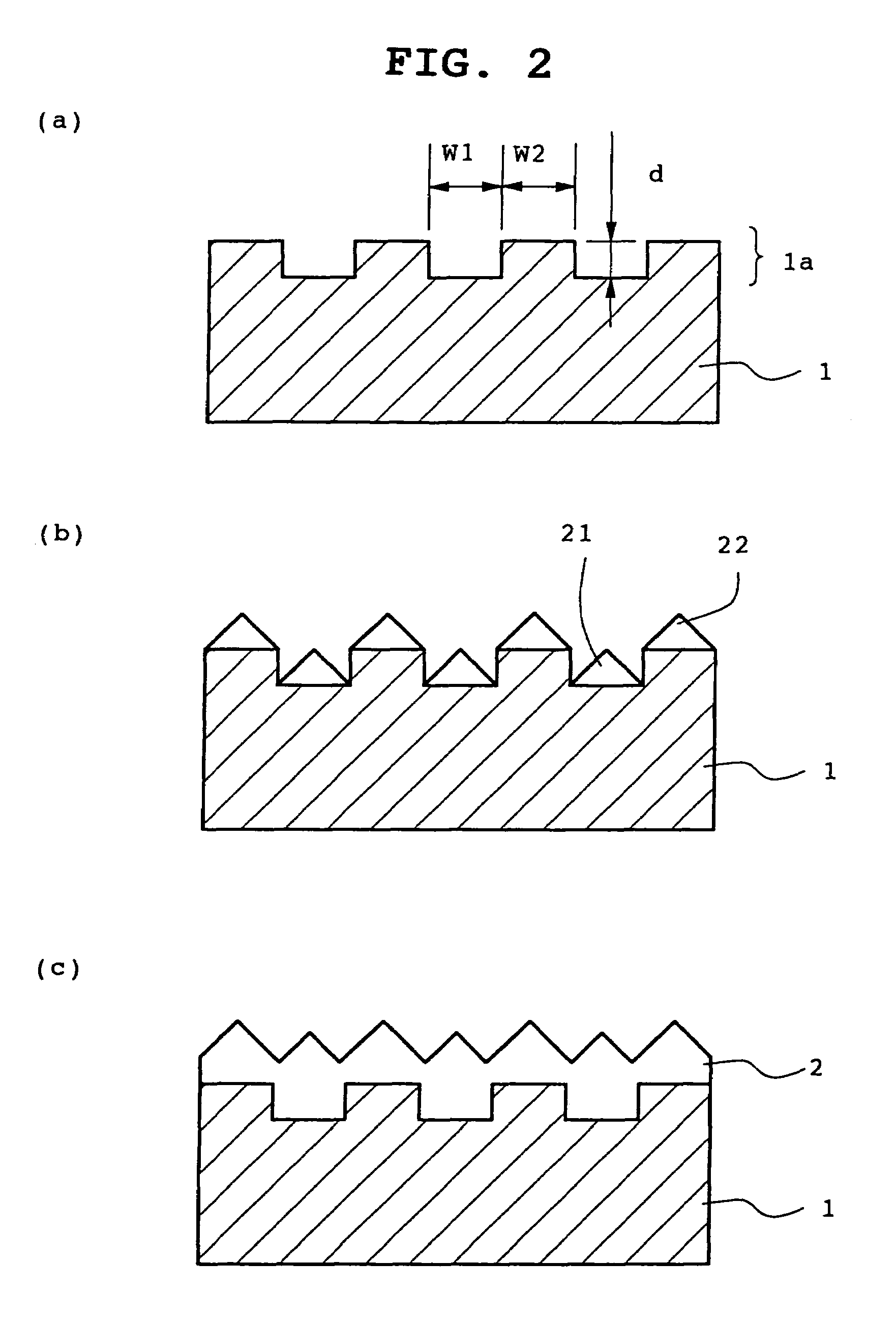GaN group semiconductor light-emitting element with concave and convex structures on the substrate and a production method thereof
a technology of semiconductor light-emitting elements and concave and convex structures, which is applied in the manufacture of semiconductor/solid-state devices, semiconductor devices, electrical devices, etc., can solve the problems of affecting the efficiency of light-emitting layer external removal, affecting the efficiency of light-emitting, and posing a cost problem
- Summary
- Abstract
- Description
- Claims
- Application Information
AI Technical Summary
Problems solved by technology
Method used
Image
Examples
example 1
[0147]In this Example, concaves and convexes of a sapphire substrate were buried by said facet growth method according to the above-mentioned embodiment (I) to give a concavo-convex refractive index interface and a GaN group LED was actually prepared as shown in FIG. 1(a).
[0148]A stripe pattern (width 2 μm, period 4 μm, stripe orientation: the longitudinal direction of the stripe is direction for GaN group crystal grown on the substrate) was formed on a C-plane sapphire substrate using a photoresist, etched with an RIE apparatus until the cross section became a 2 μm deep square, whereby a substrate having a surface having concaves and convexes of a stripe pattern was obtained as shown in FIG. 2(a). The aspect ratio then of the cross section of the stripe groove was 1.
[0149]After removing the photoresist, the substrate was set on an MOVPE apparatus and the temperature was raised to 1100° C. under a gas atmosphere (main component nitrogen) to conduct thermal cleaning. The temperature...
example 2
[0162]In this Example, a concavo-convex facet structure comprising an AlGaN crystal was formed by said facet growth method according to the above-mentioned embodiment (II), as shown in FIG. 1(b), which was buried in GaN to give a concavo-convex refractive index interface, whereby a GaN group LED was actually prepared.
[0163]In completely the same manner as in Example 1, stripe patterned concaves and convexes were formed on a C-plane sapphire substrate, which was set on an MOVPE apparatus, and the temperature was raised to 1100° C. under a gas atmosphere (main component nitrogen) to conduct thermal cleaning. The temperature was lowered to 500° C. and TMG was flown as a III group starting material, and ammonia as an N starting material, whereby a GaN low temperature buffer layer having a thickness of 30 nm was grown.
[0164]Then the temperature was raised to 1000° C. and TMG and ammonia as starting materials, whereby a GaN layer was grown in about 100 nm. Then trimethylaluminum (TMA) was...
example 3
[0168]In this Example, a concavo-convex facet structure comprising a GaN crystal was formed by said facet growth method according to the above-mentioned embodiment (II), as shown in FIG. 4(c), which was covered with 50 pairs of Bragg reflective layers having an AlGaN / GaN superlattice structure to give a concavo-convex multi-layer refractive index interface, whereby a GaN group LED was actually prepared.
[0169]In completely the same manner as in Example 1, stripe patterned concaves and convexes were formed on a C-plane sapphire substrate, which was set on an MOVPE apparatus, and the temperature was raised to 1100° C. under a gas atmosphere (main component nitrogen) to conduct thermal cleaning. The temperature was lowered to 500° C. and TMG was flown as a III group starting material, and ammonia as an N starting material, whereby a GaN low temperature buffer layer having a thickness of 30 nm was grown.
[0170]Then the temperature was raised to 1000° C. and TMG and ammonia as starting mat...
PUM
 Login to View More
Login to View More Abstract
Description
Claims
Application Information
 Login to View More
Login to View More - R&D
- Intellectual Property
- Life Sciences
- Materials
- Tech Scout
- Unparalleled Data Quality
- Higher Quality Content
- 60% Fewer Hallucinations
Browse by: Latest US Patents, China's latest patents, Technical Efficacy Thesaurus, Application Domain, Technology Topic, Popular Technical Reports.
© 2025 PatSnap. All rights reserved.Legal|Privacy policy|Modern Slavery Act Transparency Statement|Sitemap|About US| Contact US: help@patsnap.com



